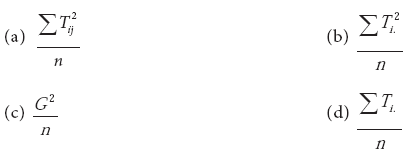Q1. ANOVA was developed by
(a) S.D. Poisson
(b) Karl Pearson
(c) R.A. Fisher
(d) W.S. Gosset
Correct Answer C
Q2. ANOVA technique originated in the field of
(a) Industry
(b) Agriculture
(c) Medicine
(d) Genetics
Answer (b) Agriculture
Q3. One of the assumptions of ANOVA is that the population from which the samples are drawn is
(a) Binomial
(b) Poisson
(c) Chi-square
(d) Normal
Correct Answer (d) Normal
Q4. In one-way classification the total variation can be split into
(a) Two components
(b) Three components
(c) Four components
(d) Only one components SSE
(d) SST+SSB
Correct Answer (a) Two components
Q5. The null hypothesis in the ANOVA is that all the population means are
(a) Equal
(b) Variable
(c) Unequal
(d) none of the above
Correct Answer (a) Equal
Q6. In one-way classification with 30 observation and 5 treatments the degrees of freedom for error is
(a) 29
(b) 4
(c) 25
(d) 150
Correct Answer (c) 25
Q7. In two-way classification the total variation TSS is
(a) SST+SSB+SSE
(b) SST-SSB+SSE
(c) SST+SSB-SSE
(d) SST+SSB
Correct Answer (a) SST+SSB+SSE
Q8. In two-way classification if TSS = 210, SST = 32, SSB = 42 then SSE =
(a) 126
(b) 74
(c) 136
(d) 178
Correct Answer (c) 136
Q9. In two-way classification with 5 treatments and 4 blocks the degrees of freedom due to error is
(a) 12
(b) 19
(c) 16
(d) 15
Correct Answer (a) 12
Q10. The formula for comparing three or more means in one-way analysis of variance is
(a) F=MST/FMSE
(b) F=TSS/FSST
(c) F=MSB/FMST
(d) F=MST/FMSB
Correct Answer (a) F=MST/FMSE
Q11. ———-test is used to compare three or more means.
(a) t
(b) χ2
(c) F
(d) Z
Correct Answer (c) F
Q12. When there is no significant difference among three or more means the value of F will be close to
(a) 0
(b) -1
(c) 1
(d) ∞
Correct Answer (c) 1
Q13. F-test is also called as
(a) mean ratio test
(b) variance ratio test
(c) variance test
(d) standard deviation ratio test
Correct Answer (b) variance ratio test
Q14. The Analysis of Variance procedure is appropriate for testing the equivalence of three or more population
(a) variances
(b) proportions
(c) means
(d) observations
Correct Answer (c) means
Q15. In two-way classification with ‘m’ treatments and ‘n’ blocks the degrees of freedom due to error is
(a) mn-1
(b) m-1
(c) n-1
(d) (m-1)(n-1)
Correct Answer (d) (m-1)(n-1)
Q16. If the calculated value of F is greater than the critical value at the given level of significance then the H0 is
(a) Rejected
(b) Not rejected
(c) Always true
(d) Sometimes true
Correct Answer (a) Rejected
Q17. —– and —– causes are present in Analysis of Variance techniques
(a) Chance, error
(b) Fixed, block
(c) Assignable, chance
(d) Assignable, fixed
Correct Answer (c) Assignable, chance
Q18. In ANOVA, the sample observations are
(a) dependent
(b) independent
(c) equal
(d) unequal
Correct Answer (b) independent
Q19. The correction factor is —– in ANOVA (with the usual notations).

Correct Answer C
Q20. Mean Sum of Squares is the ratio of Sum of Squarea to its
(a) number of blocks
(b) number of treatments
(c) degrees of freedom
(d) total sum of squares
Correct Answer (c) degrees of freedom
Total Views: 240
